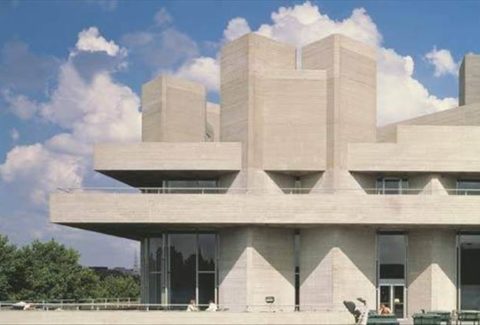The National Theatre in London is one of the United Kingdom's two most prominent publicly funded theatre companies, alongside the Royal Shakespeare Company.
From its foundation in 1963 until 1976, the company was based at the Old Vic theatre in Waterloo. The current building was designed by architects Sir Denys Lasdun and Peter Softley and contains three stages, which opened individually between 1976 and 1977. It is located next to the Thames in the South Bank area of central London.
Since 1988, the theatre has been permitted to call itself the Royal National Theatre, but the full title is rarely used. The theatre presents a varied programme, including Shakespeare and other international classic drama; and new plays by contemporary playwrights. Each auditorium in the theatre can run up to three shows in repertoire, thus further widening the number of plays which can be put on during any one season.
HISTORY OF THE ROYAL NATIONAL THEATRE
In 1847, a critic using the pseudonym Dramaticus published a pamphlet describing the parlous state of British theatre. Production of serious plays was restricted to the patent theatres, and new plays were subjected to censorship by the Lord Chamberlain's Office. At the same time, there was a burgeoning theatre sector featuring a diet of low melodrama and musical burlesque; but critics described British theatre as driven by commercialism and a 'star' system. There was a demand to commemorate serious theatre, with the "Shakespeare Committee" purchasing the playwright's birthplace for the nation demonstrating a recognition of the importance of 'serious drama'. The following year saw more pamphlets on a demand for a National Theatre from London publisher, Effingham William Wilson. The situation continued, with a renewed call every decade for a National Theatre, particularly around 1879 when the Comédie-Française took a residency at the Gaiety Theatre, described in The Times as representing "the highest aristocracy of the theatre". The principal demands now coalesced around: a structure in the capital that would present "exemplary theatre"; that would form a permanent memorial to Shakespeare; a supported company that would represent the best of British acting; and a theatre school.
Some gains were made, when the Shakespeare Memorial Theatre was opened in Stratford upon Avon on 23 April 1879, with the New Shakespeare Company; and Herbert Beerbohm Tree founded an Academy of Dramatic Art at Her Majesty's Theatre in 1904. This still left the capital without a national theatre. A London Shakespeare League was founded in 1902 to develop a Shakespeare National Theatre and – with the impending tri-centenary in 1916 of his death – in 1913 purchased land for a theatre in Bloomsbury, an aspiration which was interrupted by World War I. Finally, in 1948, the London County Council presented a site close to the Royal Festival Hall for the purpose, and a "National Theatre Act", offering financial support, was passed by Parliament in 1949.
The National Theatre building houses three separate auditoria:
– The Olivier Theatre (named after the theatre's first artistic director, Laurence Olivier), is the main auditorium, and was modelled on the ancient Greek theatre at Epidaurus; it has an open stage and a fan-shaped audience seating area for 1,160 people. An ingenious 'drum revolve' (a five-storey revolving stage section) extends eight metres beneath the stage and is operated by a single staff member. The drum has two rim revolves and two platforms, each of which can carry ten tonnes, facilitating dramatic and fluid scenery changes. Its design ensures that the audience's view is not blocked from any seat, and that the audience is fully visible to actors from the stage's centre. Designed in the 1970s and a prototype of current technology, the drum revolve and a multiple 'sky hook' flying system were initially very controversial and required ten years to commission, but seem to have fulfilled the objective of functionality with high productivity.
– The Lyttelton Theatre (named after Oliver Lyttelton, the National Theatre's first board chairman) has a proscenium-arch design and can accommodate an audience of 890.
– The Cottesloe Theatre (named after Lord Cottesloe, chairman of the South Bank Theatre board) is a small, adaptable studio space, designed by Iain Mackintosh, holding up to 400 people depending on the seating configuration.
The National also has a Studio, the National's research and development wing, founded in 1984. The Studio has played a vital role in developing work for the National's stages and throughout British theatre. Writers, actors and practitioners of all kinds can explore, experiment and devise new work there, free from the pressure of public performance. The National Theatre Archive is housed in the same building, which is across the road from the Old Vic in the Cut, Waterloo, and used to house their workshops.

